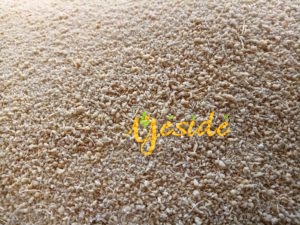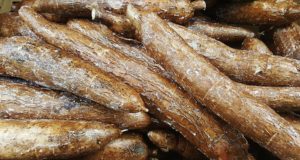
Gari or Garri is a fermented and roasted food made from Cassava. It is one of the most popular foods derived from Cassava. There are about 200 million people Across West Africa consuming Gari. Other Cassava products include Fufu, Pupuru, Lafun. The word Gari or Garri is said to be of Hausa origin meaning flour or grinded grain.
Garri is obvious a staple in West Africa. Countries like Nigeria, Ghana, Republic of Benin, Togo, and Sierra Leone enjoy it.
Gari is either taken as a cold snack often with sugar and other accompaniments like groundnuts, and milk. It is also cooked into a stiff porridge and consumed with different soups or stews. In some ethnic groups in Nigeria, it is used as a soup thickener. It can also be sprinkled on Beans porridge.

How is Gari Made?
Gari is produced by grating cassava roots, dewatering and then fermenting before roasting or ‘frying’ the fermented mash. Other variations in Gari-making include addition of palm oil as in the case of Yellow gari.
Processing is very important in utilizing Gari. This is because during the processing of Cassava, toxic substances such as hydrogen cyanide present in the cassava are removed.
How Much calorie is in Gari?

100g of Roasted Gari (dry, white) contains 363.19kcal of energy (Nigerian food composition table 2017). Most of this energy is from carbohydrate (86.89g). Protein content is very low at 0.16g and the fat content is negligble. Micronutrient content is also very low.
If you are drinking Garri as a cold snack, 6 tablespoons of dry white Gari will give you about 218 kcal. Sanusi and Olurin 2012 reported 7.5 tablespoons of Gari to be the average quantity of consumption in the South West.
If you decide to cook the Gari into a stiff porridge called Eba, then you will get 98.74kcals from 100g. However, note that the average commonly consumed portion size of Eba in the South West is about 395g (Sanusi and Olurin 2012).
For the Yellow Gari (Eba) that has palm oil added during the processing, a 100g will give you 117kcals. However, yellow Gari contains more fibre and sugar content compared to the white gari and the beta carotene (vitamin A) is higher (Oluba et al 2017).
Glycemic Index of Gari
One important fact to note about foods that have high carbohydrate content such as Gari is how quickly it raises the blood sugar level when consumed. What happens if you eat foods that have high glycemic index (70-100) is that your blood sugar level rises rapidly giving you a burst of energy. This is then followed by storing of fat in the body before you feel tired and then hungry again. This can be particularly problematic for people with diabetes Mellitus and those who want to lose weight. Highly processed foods such as bread, fries, and pastries have high glycemic index.
Foods that have low glycemic index (≤55) have an opposite effect. You do not have a spike in blood sugar, glucose is released gradually into the blood stream, you can manage your weight better and overall health can improve. Many vegetables have low glycemic index.
How quickly does Garri (Eba) raise the blood sugar?

Gari and Eba have a high glycemic index. However, how the Gari is processed and how Eba is consumed (e.g. with soup) affects the glycemic index. The more processing done on cassava, the higher the glycemic index. For instance, a study showed that the longer Gari is fermented, the higher the glycemic index.
It is well established that adding fibre, fat and protein to foods with high glycemic index can reduce the glycemic effect on the body.
An evaluation of glycemic indices of Eba (made from IJebu Gari and Egba Gari) was carried out by Fagbayigbo 2012 in Ogun State. The study showed that Eba eaten with Ogbono soup had high glycemic index (89-93 depending on the variety of Gari).
Another study by Oluba et al 2017 showed that Eba made with yellow Gari had a lower glycemic index (76.3) than Eba made from white Gari (85.7).
The bottom line, Gari is a meal that can supply you with carbohydrates. To enjoy the benefits and eliminate or reduce the negative effects, consume it with foods high in fibre, fat and protein.
If you want to reduce some weight, you might need to reduce quantity or frequency of Eba/Gari consumption. You can also ensure that you eat foods high in fibre like vegetables and pair them with great protein sources and healthy fat.
Remember that it always pays to know what’s on your plate. Don’t forget to eat better and live better.
Notes:
- Oluba OM, Oredokun-Lache AB, Odutuga AA. Effect of vitamin A biofortification on the nutritional composition of cassava flour (gari) and evaluation of its glycemic index in healthy adults. J Food Biochem. 2017;e12450. https://doi.org/10.1111/jfbc.12450
- Ihediohanma, N.C., 2011. Determination of the glycemic indices of three different cassava granules (Garri) and the effect of fermentation period on their glycemic responses. Pak. J. Nutr. 10, 6 – 9.
- S. Omoregie, A.U. OsagieGlycemic indices and glycemic load of some Nigerian foods. Pakistan Journal of Nutrition, 7 (2008), pp. 710-716
- Sanusi RA and Olurin A. (2012). Portion and Serving Sizes of Commonly consumed foods in Ibadan, Southwestern Nigeria. African Journal of Biomedical Research Vol. 15; 149-158.
- Nigerian Food Composition Table 2017



I’m confused about why fermentarion would increase the glycemic index of gari. Fermentation usually lowers the carb content, I believe.
Thanks much for the research. The info here is some of the most unbiased.
Thank you
Thank you so much for this article.
this finding is very insighful
Great. Thank you.
hi Yeside.., i am a bit confused by this explanation. You mean 100g of soaked garri has way less calories than 100g of raw garri? how so pls? is that like 100g weighed with garri already soaked in water OR by weighing it 100g dry and then soaking it in water or any other liquid??( I hope my question is not too confusing).
Your response will mean alot to me. Thanks
Hi Nenye,
Your question is not confusing at all.
What i wrote implied 100g of already soaked garri. Meaning that you soak the garri before measuring. And surely, the quantity of dry garri that you soak would definitely not be up to 100g to get 100g of soaked garri.
However, i checked the source of my data for the soaked garri information and I tried to replicate the measurement myself but the result i got was conflicting so i am removing the information about soaked garri from the article.
However, be rest assured that dry garri itself will give you about 363kcal and this corresponds with the recent West African food composition table (2019). From my own measurement, about 6 tablespoons of dry white garri will give you about 60g of dry white garri (217.8kcal) based on the dry garri calculation.
Just a correction. 6 table spoons of dry white garri should give you 90g of garri and not 60g as you stated, since 1 tablespoon is equivalent to 15g.
Thanks for your comment. I would have agreed with you since 1 tablespoon is equivalent to 15g for dry measures like flour but I used a standard measuring tablespoon and though the scale I used may not the best in terms of sensitivity , what I measured was 60g, repeating this about three different times. I repeated the measurements on different days too using the household tablespoon and got a little variation but still closer to 60g than 90g. But thanks for pointing this out.
This article is very educative especially to those of Africans that love garri as a stable food. I have share this articles with my loved ones, information is key!
Please how does fermentation increase or affect the glycemic index of garri
Thanks a lot for this work. I didn’t even realise these kind of research existed for Nigerian foods. Glad I found it